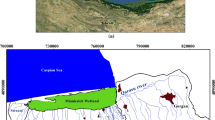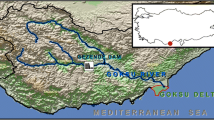Abstract
In recent years, wetland ecological water requirements (EWRs) have been estimated by using hydrological and functional approaches, but those approaches have not yet been integrated for a whole ecosystem. This paper presents a new method for calculating wetland EWRs, which is based on the response of habitats to water level, and determines water level threshold through the functional integrity of habitats. Results show that in the Huanghe (Yellow) River Delta water levels between 5.0 m and 5.5 m are required to maintain the functional integrity of the wetland at a value higher than 0.7. One of the dominant plants in the delta, Phragmites australis, tolerates water level fluctuation of about ± 0.25 m without the change in wetland functional integrity. The minimum, optimum and maximum EWRs for the Huanghe River Delta are 9.42×106 m3, 15.56×106 m3 and 24.12×106 m3 with water levels of 5.0 m, 5.2 m and 5.5 m, corresponding to functional integrity indices of 0.70, 0.84 and 0.72, respectively. A wetland restoration program has been performed, which aims to meet these EWRs in attempt to recover from losses of up to 98% in the delta’s former wetland area.
Similar content being viewed by others
References
Allan J, Lovett S, 1997. Impediments to Managing Environmental Water Provisions. Canberra: Bureau of Resource Sciences.
Bian Zhengfu, Zhang Guoliang, 2000. Application of bio-diversity indices to mined land reclamation. Journal of China Coal Society, 25(1): 76–80. (in Chinese)
Boar R R, 2006. Responses of a fringing Cyperus papyrus L. swamp to changes in water level. Aquatic Botany, 84(2): 85–92. DOI: 10.1016/j.aqubot.2005.07.008
Boyce R L, Elison P C, 2001. Choosing the best similarity index when performing fuzzy set ordination on binary data. Journal of Vegetation Science, 12: 711–720.
Casanova M T, Brock M A, 2000. How do depth, duration and frequency of flooding influence the establishment of wetland plant communities. Plant Ecology, 147(2): 237–250. DOI: 10.1023/A:1009875226637
Chow-Fraser P, 2005. Ecosystem response to changes in water level of Lake Ontario marshes: Lessons from the restoration of Cootes Paradise Marsh. Hydrobiologia, 539(1): 189–204. DOI: 10.1007/s10750-004-4868-1
Cui Baoshan, Yang Qichun, Yang Zhifeng et al., 2009. Evaluating the ecological performance of wetland restoration in the Yellow River Delta, China. Ecological Engineering, 35(7): 1090–1103. DOI: 10.1016/j.ecoleng.2009.03.022
Denis A H, Pauline H, 2003. A desktop model used to provide an initial estimate of the ecological instream flow requirements of rivers in South Africa. Journal of Hydrology, 270(3–4): 167–181. DOI: 10.1016/S0022-1694(02)00290-1
Desgranges J L, Ingram J, Drolet B et al., 2006. Modeling wetland bird response to water level changes in the Lake Ontario-St.Lawrence River hydrosystem. Environmental Monitoring and Assessment, 113(1–3): 329–365.
Dungan J L, Perry J N, Dale MR T et al., 2002. A balanced view of scale in spatial statistical analysis. Ecography, 25(5): 626–640. DOI: 10.1034/j.1600-0587.2002.250510.x
Duvail S, Hamerlynck O, 2003. Mitigation of negative ecological and socio-economic impacts of the Diama dam on the Senegal River Delta wetland, using a model based decision support system. Hydrology and Earth System Sciences, 7(1): 133–146.
Finlayson C M, 2005. Plant ecology of Australia’s tropical floodplain wetlands: A review. Annals of Botany, 96(4): 541–555. DOI: 10.1093/aob/mci209
Finlayson C M, Lowry J, Bellio M G et al., 2006. Biodiversity of the wetlands of the Kakadu Region, northern Australia. Aquatic Science, 68(3): 374–399. DOI: 10.1007/s00027-006-085-2-3
Flinn M B, Adams S R, Whiles M R et al., 2008. Biological responses to contrasting hydrology in backwaters of Upper Mississippi River Navigation Pool 25. Environmental Management, 41(4): 468–486. DOI: 10.1007/s00267-008-9078-6
Fortney R H, Benedict M, Gottgens J F et al., 2004. Aquatic plant community composition and distribution along an inundation gradient at two ecologically-distinct sites in the Pantanal region of Brazil. Wetlands Ecology and Management, 12(6): 575–585. DOI: 10.1007/s11273-005-1763-0
Froend R, Loomes R, 2004. Approach to Determination of Ecological Water Requirements of Groundwater Dependent Ecosystems in Western Australia—A Report to the Department of Environment. Perth: Edith Cowan University.
Froend R, Loomes R, 2006. Determination of Ecological Water Requirements for Groundwater Dependent Ecosystems—Southern Blackwood and Eastern Scott Coastal Plain: Report for the Department of Water. Perth: Edith Cowan University.
Hayashi M, van der Kamp G, 2000. Simple equations to represent the volume-area-depth relations of shallow wetlands in small topographic depressions. Journal of Hydrology, 237(1–2): 74–85. DOI: 10.1016/S0022-1694(00)00300-0
Howard R J, Rafferty P S, 2006. Clonal variation in response to salinity and flooding stress in four marsh macrophytes of the northern gulf of Mexico, USA. Environmental and Experimental Botany, 56: 301–313.
Hughes D A, 2001. Providing hydrological information and data analysis tools for the determination of ecological instream flow requirements for South African rivers. Journal of Hydrology, 241(1–2): 140–151. DOI: 10.1016/S0022-1694(00)00378-4
Hughes D A, 2005. Hydrological issues associated with the determination of environmental water requirements of ephemeral rivers. River Research and Applications, 21(8): 899–908. DOI: 10.1002/rra.857
Jackson M B, Colmer T D, 2005. Response and adaptation by plants to flooding stress. Annals of Botany, 96(4): 501–505. DOI: 10.1093/aob/mci205
Kennedy M P, Milne J M, Murphy K J, 2003. Experimental growth responses to groundwater level variation and competition in five British wetland plant species. Wetland Ecology and Management, 11(6): 383–396. DOI: 10.1023/B:WETL.00000-07194.01073.6b
King J, Louw D, 1998. Instream flow assessments for regulated rivers in South Africa using the building block methodology. Aquatic Ecosystem Health and Management, 1(2): 109–124. DOI: 10.1080/14634989808656909
Krstolic J L, Hayes D C, Ruhl P M, 2006. Physical habitat classification and instream flow modeling to determine habitat availability during low-flow periods, North Fork Shenandoah River, Virginia. Scientific Investigations Report: 5025.
Laitinen J, Rehell S, Oksanen J, 2008. Community and species responses to water level fluctuations with reference to soil layers in different habitats of mid-boreal mire complexes. Plant Ecology, 194(1): 17–36. DOI: 10.1007/s11258-007-9271-3
Legendre P, Dale M R T, Fortin M J et al., 2002. The consequences of spatial structure for the design and analysis of ecological field surveys. Ecography, 25: 601–615.
Lin Zhenshan, Liu Huihong, Liu Hongyu, 2005. Non-autonomous population dynamics model for single species with Allee effect affected by human activities and its application: A case study of red-crowned cranes Grus japonensis. Acta Ecologica Sinica, 25(5): 945–951. (in Chinese).
Liu Hongyu, Li Zhaofu, Bai Yunfang, 2006. Landscape simulating of habitat quality change for oriental white stork in Naoli River Watershed. Acta Ecologica Sinica, 26(12): 4007–4013. (in Chinese).
Liu Hongyu, Li Zhaofu, LI Xiaomin, 2007. Effects of wetland landscape fragmentation on habitats of oriental white storks: A case study on northeastern Sanjiang Plain, China. Journal of Natural Resources, 22(5): 817–823. (in Chinese).
Ludwig J A, Tongway D J, Bastin G N J et al., 2004. Monitoring ecological indicators of rangeland functional integrity and their relation to biodiversity at local to regional scales. Austral ecology, 29(1): 108–120. DOI: 10.1111/j.1442-9993.2004.013-49.x
Middleton B A, 2002. Flood Pulsing in Wetlands: Restoring the Natural Hydrological Balance. New York: John & Wiley Sons.
Nicol J M, Ganf G G, Pelton G A, 2003. Seed banks of a southern Australian wetland: the influence of water regime on the final floristic composition. Plant Ecology, 168(2): 191–205.
Pallisson J, Reeber S, Carpentier A et al., 2006. Plant-water regime management in a wetland: consequences for a floating vegetation-nesting bird, whiskered tern Chlidonias hybridus. Biodiversity and Conservation, 15: 3469–3480. DOI: 10.1007/978-1-4020-5734-2
Pichancourt J B, Burel F, Auger P, 2006. A hierarchical matrix model to assess the impact of habitat fragmentation on population dynamics: an elasticity analysis. Comptes Rendus Biologie, 29(1): 31–39. DOI: 10.1016/j.crvi.2005.09.009
Powell S J, Letcher R A, Croke B F W, 2008. Modelling floodplain inundation for environmental flows: Gwydir wetlands, Australia. Ecological Modeling, 211(3–4): 350–362. DOI: 10.1016/j.ecolmodel.2007.09.013
Reid M A, Brooks J J, 2000. Detecting effects of environmental water allocations in wetlands of the Murray-Darling Basin, Austrilia. Regulated Rivers: Research and Management, 16(5): 479–496. DOI: 10.1002/1099-1646(200009/10)16:5〈479:: AID-RRR599〉3.0.CO;2-Y
Riis T, Hawes I, 2002. Relationships between water level fluctuations and vegetation diversity in shallow water of New Zealand lakes. Aquatic Botany, 74(2): 133–148. DOI: 10.1016/S0304-3770(02)00074-8
Robertson H A, James K R, 2002. Determining the water requirement for the rehabilitation of wetland habitat at Kanyapella Basin, Victoria. Ecological Management and Restoration, 3: 220–221.
Schaub M, Pradel R, Lebreton J D, 2004. Is the reintroduced white stork (Ciconia ciconia) population in Switzerland self-sustainable? Biological Conservation, 119(1): 105–114. DOI: 10.1016/j.biocon.2003.11.002
Sim L L, Davis J A, Chambers J M, 2006. Ecological regime shifts in salinised wetland systems. II. Factors affecting the dominance of benthic microbial communities. Hydrobiologia, 573(1): 109–131. DOI: 10.1007/s10750-006-0268-z
Smakhtin V, Revenga C, Doll P, 2004. Taking into account environmental water requirements in global-scale water resources assessments. Comprehensive Assessment Report 2. Colombo, Sri Lanka: Comprehensive Assessment Secretariat.
Smakhtin V U, 2001. Low flow hydrology: A review. Journal of Hydrology, 240(3–4): 147–186. DOI: 10.1016/S0022-1694(00)00340-1
Smakhtin V U, Eriyagam N, 2008. Developing a software package for global desktop assessment of environmental flows. Environmental Modelling & Software, 23(12): 1396–1406. DOI: 10.1016/j.envsoft.2008.04.002
Smith R G B, Brock M A, 2007. The ups and downs of life on the edge: the influence of water level fluctuations on biomass allocation in two contrasting aquatic plants. Plant Ecology, 188(1): 103–116. DOI: 10.1007/s11258-006-9151-2
Sun Tao, Yang Zhifeng, Shen Zhenyao et al., 2009. Environmental flows for the Yangtze Estuary based on salinity objectives. Communications in Nonlinear Science and Numerical Simulation, 14(3): 959–971. DOI: 10.1016/j.cnsns.2007.10.006
Tharme R E, King J M, 1998. Development of the building block methodology for instream flow assessments and supporting research on the effects of different magnitude flows on riverine ecosystems. Water Research Commission Report No 576/1/98. Pretoria, South Africa.
Ulrich K, Rainer B, Konrad H, 2004. Assessment of river habitat in Brandenburg, Germany. Limnologica, 34(3): 176–186. DOI: 10.1016/S0075-9511(04)80043-4
White S D, Deegan B M, Ganf G G, 2007. The influence of water level fluctuations on the growth of four emergent macrophyte species. Aquatic Botany, 86(4): 309–315. DOI: 10.1016/j.aqu-abot.2007.01.006
Whittaker R H, 1960. Vegetation of the Siskiyou Mountains, Oregon and Califonia. Ecological Monographs, 30(3): 279–338. DOI:10.2307/1943563
Wilcox D A, Sweat M J, Carlson M L et al., 2006. A water-budget approach to restoring a sedge fen affected by diking and ditching. Journal of Hydrology, 320(3–4): 501–517. DOI: 10.1016/j.jhydrol.2005.07.026
Wolanski E, Boorman L A, Chicharo L et al., 2004. Ecohydrology as a new tool for sustainable management of estuaries and coastal waters. Wetlands Ecology and Management, 12(4): 235–276. DOI: 10.1007/s11273-005-4752-4
Wolfgang O, 2004. New approaches to integrated quality assessment of lakeshores. Limnologica, 34(1–2): 160–166. DOI: 10.1016/S0075-9511(04)80036-7
Yang Zhifeng, Cui Baoshan, Liu Jingling, 2005. Estimation methods of eco-environmental water requirements: Case study. Science in China (Series D), 48(8): 1280–1292. DOI: 10.1360/02yd0495
Zhang Xiangwei, Takeuchi K, 2004. Methodology for modeling of groundwater flow in large area. Journal of Hydraulic Engineering, 35(6): 7–13. (in Chinese)
Author information
Authors and Affiliations
Corresponding author
Additional information
Foundation item: Under the auspices of Major State Basic Research Development Program of China (No. 2006CB403303), National Natural Science Foundation of China (No. U0833002, 40571149), Scientific Research Foundation of Beijing Normal University (No. 2009SD-24)
Rights and permissions
About this article
Cite this article
Cui, B., Hua, Y., Wang, C. et al. Estimation of ecological water requirements based on habitat response to water level in Huanghe River Delta, China. Chin. Geogr. Sci. 20, 318–329 (2010). https://doi.org/10.1007/s11769-010-0404-6
Received:
Accepted:
Published:
Issue Date:
DOI: https://doi.org/10.1007/s11769-010-0404-6




